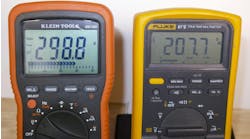Protecting susceptible electronic equipment from AC power line disturbances is a major concern for most people, whether their business environment is commercial or industrial.
No matter what the setting, computers are subject to data errors, crashing, and even damage or destruction by voltage transients as a result of an absence or misapplication of protective devices. Similarly, programmable logic controllers (PLCs), solid-state motor controllers, variable-speed drives (VSDs), and communications equipment all can be damaged from transients.
This damage can be immediate, as when the transient voltage causes a breakdown of solid-state components due to the energy of the transient, or latent, as when insulation or components are severely stressed by a single transient or several transients but not to the point of immediate failure. In the latter case, a transient or other stress that would normally cause no problem affects the weakened insulation or component, causing it to fail without any apparent reason.
What are these transients, and where do they come from? To properly apply transient protection, you need to know the answers to these questions.
We generally divide transients into two main categories: those that are derived from natural causes, such as lightning; and those generated through the use of equipment, either on-site or elsewhere.
Lightning. A lightning stroke can produce much more energy than we previously thought possible. In fact, a “typical” lightning stroke can carry nearly 3 billion kW at approximately 125 million volts, with an average current of more than 20,000A. In addition to this prodigious energy production and its dramatic visual display, lightning also produces extremely powerful, short-duration transients on power distribution systems — either by a direct strike or a near hit. In most instances, a lightning strike-induced surge on local power distribution lines causes damage to susceptible equipment.
Lightning strikes can also have secondary effects that cause problems to susceptible electronic equipment in a building. Circuit breakers protecting utility lines can trip and then try to reclose. The resulting voltage sags and outages can cause more problems to computers and other electronic devices than the voltage transients themselves.
A useful representation of the wave behavior of lightning-induced energy is a diagram (Fig. 1 above) from the venerable and pioneering FIPS PUB 94, “Guideline on Electrical Power for ADP Installations,” published in September 1983 and withdrawn July 29, 1997.
Looking at this diagram, let's assume the pad-mounted transformer that's feeding the building is rated 13.8kV-480Y/277V and is served by a 13.8kV overhead distribution line. Further, let's assume the overhead line, which is being struck by lightning, is protected with lightning arresters (LAs) rated to spark over at approximately 30kV.
This level of protection provides for the full peak capability of the 13.8kV distribution line while protecting the system from any increased discharge problems. The wiring system and the apparatus connected to it are most likely rated for 95kV BIL (basic impulse insulation level). With the lightning arresters operating as required, cross arms, wire and insulation, insulators, and the transformer's primary insulation are safely protected.
While the lightning charge is building up to 30kV on the overhead power lines, the resultant increasing energy acts as a traveling wave, traversing the overhead lines through Points 1, 2, and 3. At any point where this wave encounters a “discontinuity,” it then treats that point as a reflecting point, as indicated by the U-shaped arrow at Point 3. In reflecting back along the line, the reflected traveling wave follows the laws of physics and doubles in voltage. If the wave is traveling into the reflecting point at 30kV, the reflected traveling wave will travel out of and away from the reflecting point at 60kV. This doubling effect takes place at dead-ends, open disconnect switches, or the front end of transformer primaries.
Surges induced by equipment. Arresters at the service entrance will not necessarily eliminate all power line surges within a building. Although greatly reduced in magnitude, those surges that slip by can add to transients that are generated within the facility, causing significant problems to susceptible electronic equipment located there.
Equipment-caused transient voltages result from the basic nature of alternating current. A sudden change in an electrical circuit will generate a transient voltage due to the stored energy contained in any circuit inductances (L) and capacitances (C). The size and duration of the transient depends on the value of L and C and the applied waveform.
Continuous surges. These surges, which can range from 250V to 1,000V, can come from operation of electric motors or other inductive loads. Other causes include DC motor drives, the power electronics of VSDs, DC power supply switching, and even portable tools.
Momentary surges. These surges, which can range from 250V to 3,000V, can originate from the switching of inductive loads. When you interrupt an inductor's current, a surge voltage will be generated. Its magnitude is described by the equation e = L × di/dt, where the voltage is equal to the inductance times the rate of current shutdown.
The opening and closing of electric motor starters or the use of arc welders and furnace igniters can induce these surges. When the conductors carrying these surge currents are in proximity to conductors of signaling or data circuits, induced voltages will be generated within these circuits. The result is the introduction of electrical noise and loop currents.
Deenergizing inductive circuits with air-gap switches such as relays and contactors, can generate bursts of high-frequency impulses. Figure 2 above shows an example of these phenomena. ANSI/IEEE C62.41-1991, “Recommended Practice for Surge Voltages in Low-Voltage AC Power Circuits,” cites a representative 15-millisecond (.015 second) burst composed of impulses having 5-nanosecond (.000000005 second) rise times and 50-nanosecond durations.
We call these electrical fast transients or EFTs. While there is very little energy in these types of transients, due to their short duration, they still can interfere with the operation of electronic loads. Cycling motors, such as air conditioners and elevators, frequently cause EFTs, which are capable of producing spikes up to 1kV. The operation of arc welders and motor starters can cause transients as high as 3kV.
Capacitor switching. While this is one of the most common switching events on utility systems, it is one of the main causes of oscillatory transients. (See March 2006 issue article “Understanding Transients: A Primer,” on page 38)
Figure 3 (right) shows a typical utility-capacitor switching one-line diagram and resulting oscillatory transient waveform from a capacitor switching operation. This transient can propagate into the utility's local power system, pass through its distribution transformers, and enter into the end-user's load facilities. The extent of the transient's energy is a function of the turns ratio of the transformer feeding the end-user facility.
A common symptom that directly relates to utility capacitor switching overvoltages is that the resulting oscillatory transients appear at nearly identical times each day. This is because electric utilities, in anticipation of an increase in load, frequently switch their capacitors by time clock.
The resulting conditions you can expect to see as a result of this switching include VSD tripping as well as misoperation of other electronically controlled equipment — all without any blinking of lights or other noticeable effects on more conventional loads.
There's a potential side effect to this scenario: magnification of the utility capacitor-switching transients. This can occur when the end-user adds power factor correction capacitors at its facility. These capacitors can, in fact, magnify the transient overvoltages for certain low-voltage capacitor and step-down transformer sizes.
One way to counter this potential problem is for the electric utility to use synchronous closing breakers or switches with preinsertion resistors. Another way is to use high-energy surge arresters at the end-user location to limit the magnitude of the transient voltage at the end-user bus.
Still another way is to convert end-user power factor capacitor banks to harmonic filters. Appearing as an inductance in series with capacitors, these filters decrease transient voltages at the end-user bus to acceptable levels. This solution has multiple benefits:
-
Correction for displacement power factor,
-
Control of harmonic distortion levels, and
-
Limitation of magnified capacitor-switching transients.
To correct power system problems that affect susceptible electronic equipment, you must first identify the source or sources of these problems. Symptoms and timing play an important part. In the case of transient overvoltages, nature may be the culprit, as in the case of lightning. Applying equipment designed to improve system performance and save money, as in the case of switched capacitors, motors, and contactors, may also cause problems.


